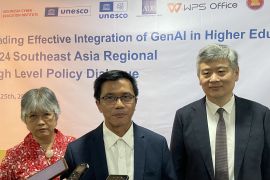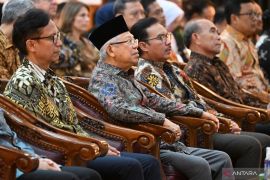SINGAPORE, Dec. 11, 2012 (ANTARA/PRNewswire) -- The second DHL Global Connectedness Index (GCI) has revealed that the world is less globally connected than it was in 2007, signaling that improvements could be a way out of the economic doldrums for many economies. The report, a detailed analysis of 140 countries and the flows that connect them, draws on over one million data points from 2005 to 2011 creating a comprehensive analysis of the state of globalization today.
(Logo: http://www.prnasia.com/sa/2010/09/02/20100902467742-l.jpg )
Six Asian countries are ranked in the top 25 for overall connectedness -- a measure of both their depth and breadth of connectivity - with Singapore ranked 2, Hong Kong (12), South Korea (14), Thailand (15), Malaysia (16) and Taiwan (21). On the depth scale, Hong Kong led the global rankings with Singapore at number 2. As a region, East Asia/Pacific is ranked second in terms of depth of global connectedness -- a measurement of four components (trade, capital, people and information flows) -- and ranked third overall after leaders Europe and North America. However the region topped the trade flow pillar.
Jerry Hsu, CEO, Asia Pacific, DHL Express, said: "The DHL Global Connectedness Index rightly debunks the damaging myth of total globalization as 'globaloney' (Note 1). The index reveals a world operating in a range of 10-20% globalization with 50-60% of international flows happening intra-regionally. This means there's still huge potential for greater connectivity between countries especially since levels remain lower than the financial crisis. The potential gains could reach trillions of dollars and during this period of slower growth, greater international connectedness should be embraced as a vital engine for economic recovery and prosperity."
Kelvin Leung, CEO, Asia Pacific, DHL Global Forwarding, said: "The major economies within Asia-Pacific and the region itself are comparatively well connected, and it tops the global trade flow pillar. This is despite trade between high-income countries having stagnated. To maintain any positive momentum, however, governments must resist protectionist measures that hinder cross-border interactions and any effort or initiative to ease trade flows must be supported."
While the world as a whole experienced only a very modest increase in global connectedness from 2010 to 2011 according to the GCI, some individual countries had large gains. The largest gainers are Mozambique, Togo, Ghana, Guinea and Zambia -- all in Sub-Saharan Africa. While this region remains the world's least connected, it averaged the largest connectedness increases from 2010 to 2011. Europe remains the world's most connected region, with Netherlands as the world's most connected country.
In 2012, the GCI also included an analysis of industry-level connectedness for the first time across 20 industries. The results reveal how industry connectedness is being impacted by the rise of emerging markets, particularly in pharmaceuticals, automobiles and mobile phones.
Paul Graham, CEO, Asia Pacific, DHL Supply Chain, said: "The migration of production and consumption to emerging markets has specific implications for the three industries highlighted in the report -- pharmaceuticals, passenger cars and mobile phones. DHL's Global Connectedness Index 2012 concludes that the world's shifting economic center of gravity is reshaping industry connectedness and offers valuable lessons on how companies can adapt their strategies to benefit from the changing geography of production and consumption."
The 2012 edition of the GCI also includes case studies on Mexico and Vietnam and offers eight recommendations to help countries enhance or expand their connectedness with the rest of the world. This new chapter also highlights evidence that the depth of global connectedness -- the proportion of flows that cross national borders -- contributes to economic development and prosperity.
The GCI was commissioned by DHL and conducted by world-renowned global business strategist and economist, Pankaj Ghemawat, Professor of Global Strategy at the IESE Business School, Barcelona. It documents how global connectedness grew robustly from the report's baseline year of 2005 to 2007, and then dropped sharply at the onset of the financial crisis.
"The benefits of expanding merchandise trade are much larger than traditional models indicate," explains Professor Ghemawat. "Adding to that the gains from services trade and other kinds of cross-border flows, the estimated economic benefits double to at least 8% of global GDP."
Note:
1. http://www.barrypopik.com/index.php/new_york_city/entry/globaloney_global_baloney/: Oxford English Dictionary, globaloney, Etymology: Blend of global and baloney; chiefly U.S. Nonsensical or absurd talk or ideas concerning global issues.
- End -
Note to editors:
The DHL Global Connectedness Index 2012 as well as supplemental background information can be downloaded at www.dhl.com/gci.
Frank Appel and Pankaj Ghemawat will also illustrate why global connectedness matters at Deutsche Post DHL's blog www.delivering-tomorrow.com.
DHL -- The Logistics company for the world
DHL is the global market leader in the logistics industry and "The Logistics company for the world". DHL commits its expertise in international express, air and ocean freight, road and rail transportation, contract logistics and international mail services to its customers. A global network composed of more than 220 countries and territories and about 275,000 employees worldwide offers customers superior service quality and local knowledge to satisfy their supply chain requirements. DHL accepts its social responsibility by supporting climate protection, disaster management and education.
DHL is part of Deutsche Post DHL. The Group generated revenue of 53 billion Euros in 2011.
For the latest news and happenings about DHL in Asia Pacific, visit http://press.ap.dhl.com.
Editor: PR Wire
Copyright © ANTARA 2012











